29 May 2012
Sadly our planned visit to Thanet Earth in mid-May had to be postponed and we are currently hoping to re-arrange a visit there on 27 June. However the joint visit with PHGSW to the Wareham area of Somerset did go ahead, and is reported below.
During the month Geoff Dixon represented the Group at the National Horticultural Forum's Research Providers' meeting held on 8 May. His report appears in 'News from our Associates' below. Earlier in the year Geoff also represented the Group at the Green Skills Seminar organised by the Royal Horticultural Society and his report on that meeting also appears below.
For those interested in seeing the Chelsea Physic Garden there is a visit organised by the London Group on 17 June.
The Society will be holding its Annual General Meeting on 4 July and the Horticulture Group will be visiting VHB Herbs near Chichester on 11 July.
Editor
Ferns, vines, snakes and lizards
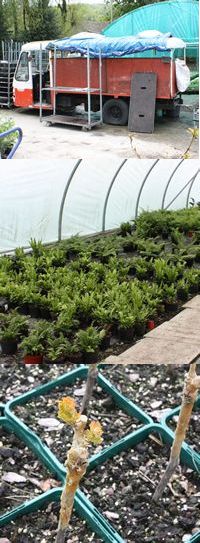
He buys in plugs and liners from specialist propagators and aims to sell all his stock within two years. He grows all his plants in peat-free compost, mainly because the National Trust is one of his larger customers but also because he revels in the challenge. The nursery boast a particularly novel potting bench constructed from an old milk float (top right).
Eschewing the common nursery stock favourites he chose ferns (centre right) as a crop he could specialise in. Five years ago they were in short supply and after a bit of research he happened upon a Dutch propagator who was producing ferns in plugs and not supplying anyone else in the UK. This gave him a head start and although others have now found this supplier he has an established a customer base who appreciate the quality he produces. He now sells around 60,000 ferns a year in fifty varieties. However, customers seldom specify varieties preferring to order a mixture and leaving him to make the selection.
Ferns are relatively trouble free to grow and his main problem is vine weevil. He has found the conventional treatments unsatisfactory and puts this down to the peat-free compost. This is not fully composted and consequently heat up in the stacks denaturing chemicals and killing biological controls. Located where he is there is abundant natural control for other pests such as slugs including birds, toads, snakes and lizards. The latter particularly like his polythene tunnels as winter lodging.
A relatively new venture is grape vines which he buys in from France as grafted stock (lower right). They currently produce 8,000 plants per year in 12 varieties; varieties selected to produce grapes for all purposes - red, white, even rose wine as well as table grapes.
Our tour then moved on to the Arne Nature Reserve run by the Royal Society for the Protection of Birds. The reserve protects a peninsular of around 1,200 acres of lowland heath (pictured below) and salt marsh on the shore of Poole harbour. Originally purchased in 1964 as one of the few remaining habitats of the Dartford Warbler the reserve now provides a home for a range of scarce and endangered birds. Even ospreys drop in on the winter migration and they live in hope that a pair will one day stay and breed. The reserve also provides one of the few homes for all the UK's native reptile including the smooth snake and sand lizard.
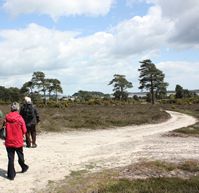
However the biggest hazards are gorse and pine seedlings. The gorse has to be cut back to prevent encroachment on the heather but they have a novel technique for removing the young pine trees. Dorset folk are invited onto the reserve before Christmas each year and in return for clearing the pine trees they get to take home a free Christmas tree. This has proved so popular that controlling numbers is more of a problem than lack of volunteers.
Much of the reserve is 'managed' by grazing with wild Sika Deer which have escaped from nearby Brownsea Island. As a result they do not have to import cattle or other domestic grazers, just maintain the balance between the deer population and the desired level of grazing. A university project is currently examining the effects of grazing across the main habitats of the reserve.
Plant of the Month
Bearded Iris cultivars, Iridaceae (eg 'Black Swan', 'Jane Phillips', 'True Charm', 'Rocket')

There are three stamens (free at the base of the falls) and three petal-like style branches which cover the stamen. Just above the anther on the outer side of the style is a little flap whose upper surface is the stigma. The plants have stiff sword-like leaves shooting from rhizomes that grow on the surface (and need the warmth of the sun) and should not be mulched.
These types of iris have a variable number of chromosomes with 2n varying from 24 to 64 (approximately), varying with increasing plant size. They are best propagated by division after flowering from midsummer to early autumn.
There are a number of different national collections of Iris, in particular Julian Browse of Seagate Irises has a collection of pre-1965 bearded iris cultivars.
The Bearded Iris can be seen looking good in the walled garden of the University of Oxford Botanic Garden now!
Alison Foster
Oxford Botanic Garden
Medicinal Plant of the Month
Iris x germanica 'Florentina', garden iris, common German flag, Iridaceae
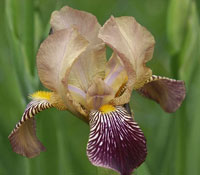
Traditionally, orris root is used as an expectorant and emulcent and therefore included in many cough remedies and antitussive medicines. It is also added to potpourris as a fixative and it used to be put on wigs and hair as a powder. It is also occasionally used to flavour liqueurs (such as Bombay Sapphire gin), toothpastes and tooth powders.
The violet fragrance of orris root is due to the oxidative degradation of carotenoids (via the enzyme carotenoid dioxygenase) to irones. Irones are a mixture of stereoisomers of 6-methylionone.

Alison Foster
Oxford Botanic Garden
Green Skills
Green Skills Seminar 21 March
An enthusiastic encouraging start came from Leigh Morris (Associate Director of Horticulture (Learning), Royal Botanic Garden Edinburgh) identifying how horticulturists can achieve productive careers. His GROW initiative has gathered momentum and recognition but as he emphasised needs a broad base of like-minded participants in order to keep the show on the road.
Enthusiasm was not the forte of David Milton (Vice-President Institute of Careers Guidance) who provided a long discourse on the problems afflicting his own Institute. But he was unable to offer any means by which school children especially in secondary education might be encouraged to consider a career in horticulture.
Problems associated with the Government's education strategies formed the theme of Stephen Dowbiggin's (Chief Executive/ Principal, Capel Manor College) presentation. Industry has long questioned the huge and confusing numbers and levels of horticultural qualification held by students. Across the whole of education these numbers of qualifications have been cut.
Quite possibly that means that some education providers should give rational thought to what they offer and why? Dr Dowbiggin advocated a 'cradle to grave professional horticultural qualification'. How that might fit with the need for a flexibly educated and trained work force equipped with motivations for moving between employers and industry sectors in response to economic circumstances was not defined.
Encouraging school children's interest in plants and growing food was discussed by Myles Bremner (Chief Executive Garden Organic). He presented findings from a Defra sponsored enquiry which focussed on the localism agenda. With great pride he regaled the audience with the focus group which achieved having 'a bishop, tabloid journalist and the Chairwoman of the WI in a room at Defra'.
In total they surveyed 1300 schools, 80% were involved with some form of food growing project, that figure fell to 72% in secondary schools. The subject is not included in the curricula. The general aim is to 'promote health and well-being in relation to diet and nutrition'. Mr Bremner applauded the educational strategy of the Agriculture and Horticulture Development Board (AHDB) which seeks to encourage awareness in schools of the sources of food, growing plants and of the businesses which produce food.
The Heritage Lottery Fund has done some very useful work promoting the acquisition of training and new skills. Currently, they are focused on the provision of training in order to provide the next generation of people capable of caring for and interpreting heritage gardens indicated Jo Reilly, Heritage Lottery Fund Head of Participation and Learning.
What industry wants is people with education and skills which match the challenges that confront them in their jobs and which they can tackle as part of a team with a 'can do' attitude. Currently the quality of education and training is far from good enough. There have been far too many changes in the way by which education and training are provided which go nowhere near reflecting what is required in the workplace indicated Steve McCurdy, Managing Director of Majestic Trees.
This company seeks to provide career progression and good rates of pay. He illustrated this by providing 'revenue earned per employee' for Haskins (£59k), Hoosmead plc (£57k), Hillier (£58k), Johnsons (£76k) and Majestic Trees (£86k), the source of these figures was not given.
Kirklees Council recruits into an apprenticeship scheme which provides individual mentoring (younger staff are partnered by older ones), induction training, workshops with permanent staff and celebrates an individual's successes indicated Steve Taylor, Area Manager for Streetscene and Housing. 'There is a considerable shortage of the younger generation in our workforce', he reported.
Over two years they have trained 25 apprentices, two moved to private industry and three were 'lost'. Potential apprentices are offered placements while still in school in order that they gain an idea of what the job is about.
The land-based sector requires an Apprentice Training Agency, advocated Madge Moore, Lantra's National Director for England. This would respond to the public's demand for more open spaces and parks and provide entry programmes which are fit for purpose.
She suggested an employer investment fund, and establishment of continuing professional development schemes. Apprentice training schemes should operate over two years, Year One providing an understanding of: arboriculture, landscape and amenity horticulture, environmental conservation, game and wildlife and aquaculture. Year Two would provide 'real work' and continuing learning. This scheme could be followed by Higher Level Apprenticeships.
Finally, the duo of Penny Evans, Horticultural Trades Association (HTA) Training and Careers Manager and Martin Emmett, Knowledge and Training Partnership (KTP) Academic Supervisor, University of Reading described the project which aims to re-establish a training culture in production horticulture. Both emphasised the failures of formal education and training programmes to provide what industry needs.
There have been a series of 'ineffective and un-sustained government initiatives' and a 'lack of relevant expertise in the training sector'. Of those who have taken part in this initiative 85% have found it useful. This scheme provides the opportunity for a sustainable structure applicable across the industry which meets the needs of industry and individuals.
Overall, it is apparent that those who provide education and skills training for aspirant horticulturists have been driven for a generation by forces which have little or no understanding of the knowledge and competencies which are necessary for those who want to join the industry in its broadest sense. Quite possibly those who formulate national education and training policies have no wish or intention of understanding what horticulture requires.
Equally, the provider institutions can be charged with having failed in making acceptable and understandable cases. Except for some very notable exceptions amongst private and public employers, industry is far from free of responsibilities for the current situation where a significant proportion of potential employees are 'not fit for purpose'. As in the research sector the results of combined failings are now apparent as critical lacks in knowledgeable and skilled staff.
Prof Geoff Dixon
News from our Associates
Commercial Horticultural Association

For those new to exporting International Hortifair opening on 30 October in Amsterdam remains one of the best starting points. Once again CHA is organising the UK presence with grants available for eligible companies.
National Horticultural Forum
Report on the Research Providers' meeting held on 8 May

Simon Bright tried to inject a more positive atmosphere by reference to the £7m HAPI (Horticulture and Potatoes Initiative) from BBSRC which will come on-stream in 2013. Dialogue between the NHF and government was suggested as one of the reasons why that money had been made available.
This influence is coming at a welcome time since it was admitted that Defra's involvement with horticulture is fading. The disastrous loss of the LINK Scheme deeply damaged industry's capacity to engage with publically funded bodies for applied R&D projects. Regrettably, the most recent documents sent by NHF to government are deemed as 'too vague' and have been returned for further work. This will be an immediate job for Simon Bright's successor Mark Tatchell. Government has woken up to the importance of food security.
The question remains, however, as to whether this applies solely to international considerations or a full recognition that at some stage this nation may need to rely much more than currently on home production as a major source of the population's food supply. The impact of climate change is given nodding acknowledgement in Whitehall but action of any substance is largely absent.
Prof Paul Hadley described the continuing research and educational work of the Centre for Horticulture and Landscape at Reading University. A very stout research department maintains the Soft Fruit Technology Centre, Curation of the National Fruit Collection at Brogdale, Kent, the World Genotype Collection of Cocoa and environmental and social studies linked with the Royal Horticultural Society. The Centre's research income stream is one of the largest in the entire University.
Much of the day was spent in an attempt to understand 'non-food' horticulture, a deeply flawed and negative appellation for environmental and social parts of the horticultural discipline. Tim Briercliffe (Horticultural Trades Association, HTA) and Ross Cameron (Sheffield University) produced powerful descriptions of these sectors, their components which add enormous tangible and non-tangible assets to the wide church which is horticulture. These presentations by professional horticulturists did much to educate those who stand on the fringes of the discipline.
The recent strategic review of the Levy Board's past, current and future funding of horticultural R&D was reviewed in detail by Bill Parker. This review draws its substance from an in-depth analysis of all projects funded by HDC since its inception by Stephen Tones. At long last money spent has been matched against achievements and failures and this honest appraisal is much to be welcomed.
The rise of Lancaster University as a centre for horticultural R&D investment was noticeable in Bill Parker's presentation. Capacities for supporting the horticultural industry by ADAS were described by Barry Mulholland. Finally, it seems ADAS has recognised that it needs some new blood in its teams and is embarked on educating and training some new entrants.
Prof Geoff Dixon
Society of Biology

It suggests that government should incentivise and support investment in early stage development research and that academics who engage in translational research should be recognised and rewarded appropriately, and supported in respect of filing IP and as founders of spin-out companies.
Horticulture Industry News
For the very latest horticultural news follow us on Facebook and or
Twitter.
Danger - Killer tomatoes
A naturally occurring compound derived from wild tomato plants is also a fast-acting, nontoxic herbicide, according to researchers at North Carolina State University. NC State entomologist Dr Mike Roe had previously worked with the compound - known as 2-undecanone - as a natural replacement for the chemical DEET in insect repellents. Both he and his NC State colleague, entomologist Dr George Kennedy, were exploring whether 2-undecanone could be used as an insecticide on plants, when they noticed an unexpected side-effect: it killed the plants.
'The discovery was a bit unexpected - we were taking this chemical from a plant, so we didn't expect it to have herbicidal qualities,' Dr Kennedy says. 'But in the wild tomato where 2-undecanone naturally occurs, it is held in tiny hairs all over the vine and fruit, so it never actually comes into contact with the plant itself.' This serendipitous discovery led the researchers to do some further testing, and they found that 2-undecanone provides both effective and fast-acting weed control. It seems to interfere with a plant's ability to retain moisture, which kills it quickly. More
Coragen secures approval for UK use against carrot fly
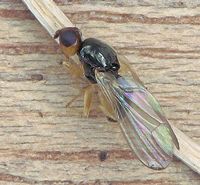
Fresh herb Company campaign starts
West Sussex grower VHB, the largest producer of fresh herbs for the UK retail market, which produces Fresh Herb Company products, is to run its first public relationscampaign. The consumer campaign is running from April to September to promote sales of fresh living herbs. The company has enlisted chefs and food writers including Atul Kochhar, Toby Tobin and Rosemary Shrager to provide their five favourite uses for fresh herbs. These will be sent, under the campaign name '5 Ways', to food and consumer magazines to try to inspire more consumers to buy and cook with living herbs. More
Growth control without light
Sunlight not only supplies plants with energy, but also controls their development steps. So-called photoreceptors activate the processes of germination, leaf development, bud formation, and blossoming in the cells. The light-absorbing component of a photoreceptor may be replaced by a chemically similar synthetic substance. The seeds and seedlings of Arabidopsis were fed with a synthetic substance named '15Ea-phycocyanobilin'.
In the plant cell, this substance replaces the natural, photoactive component of the photoreceptor, the 'phytochromobilin'. Incorporation of 15Ea-PCB activates the photoreceptor and the plant is made to believe it is exposed to light. In spite of the darkness, model plants germinate and grow similar to a control group exposed to light. It was shown for the first time that synthetic substances can cause light effects in entire plants. More
Growers to share £3m after Berry Garden turnover rises
KG Growers, known as Berry Gardens, the UK's leading berry and stone fruit production and marketing group revealed an 11 per cent rise in turnover to £214m at its AGM in May. Grower members of the cooperative, which is celebrating its 40th year, will share a pot of more than £3m, compared with £2m achieved last year.
Chairman Paul Kelsey said: 'The results support our assertion that the grower-owned cooperative model can deliver sustained longterm success for members in the highly competitive UK fruit and vegetable sector.' Berries now account for 18.4 per cent of UK fruit sales in a market valued at £783m. More
Fruit growth outstrips vegetables
Latest Defra figures have confirmed the differing fortunes of Britain's fruit and vegetable growers, with fruit showing continuing strong returns while those from vegetables have slipped back. Revenue from fruit has risen from less than two-fifths that of vegetables in 2006, to more than half in 2011.
Since 2006, fruit has shown average year-on-year growth of 10.8 per cent, slightly above the farming average of 10.4 per cent. But vegetable revenue has put on an average of just four per cent each year. Overall, the figures paint a positive picture of UK agriculture, with the headline inflation-adjusted Total Income from Farming figure up 25 per cent to £5.7bn. This is described by Defra as the best performance for the agricultural industry since the mid 1990s. More
Expanding business M&R Morton puts success down to technology
M&R Morton, which grows roses at its arable and sheep farm in Alresford, Hampshire, has branched out into the specialist sweet pea market following its purchase of Greenlines Nursery in Birdham, Chichester. Owner Rosebie Morton said specialist computer software designed to provide information about crops, costs and stock was helping to build business.
The sweet pea business is running at full capacity, with 890,000 stems under cultivation in Chichester. The company already supplies to Waitrose and is expanding its online presence, Sweet Peas Direct. It plans to build up to a million-plus stems a year in the 'near future'. More
Fourth Thanet Earth greenhouse to start
Thanet Earth, the UK's largest production site for tomatoes, peppers and cucumbers, has announced plans for the construction of a fourth greenhouse to add to its existing three facilities in Thanet, Kent. The announcement by project partners Fresca Group, A & A, Kaaij UK and Rainbow marks the first new development at Thanet Earth since it was constructed in 2009, at which time it was expected to be the first stage of a seven glasshouse, 55ha site.
Since its opening, Fresca said the Thanet Earth business had managed to negotiate its way through difficult times in the industry and the economy at large. Despite this, the group said the project had 'made extremely good progress' financially, moving from large losses in year one towards a modest profit in year three, although it admitted that the pressures on the business had been 'enormous'. More
Micron InjectorDos Pro for the control of Japanese knotweed
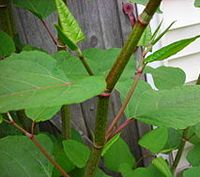
The applicator's design enables easy access to the dense growth of Japanese Knotweed (Fallopia japonica, pictured right by Andrea) while the ergonomically shaped handle aims to reduce muscle fatigue despite continuous use, offering a faster and more efficient way of treating this invasive weed. More
Gene deletion - a new breeding technique
TAL effectors are a class of bacterial protein that attaches to a small segment of host DNA making it more susceptible to the bacteria. These proteins are now ubiquitously used in biotechnology and the emerging field of synthetic biology. In the latest study, TAL-nucleases have been used to remove a small stretch of DNA from the genome of rice that rendered it susceptible to bacterial blight, an important disease that affects millions of hectares throughout Asia. More
A mechanism that gives plants 'balance'
When a plant goes into defence mode in order to protect itself against harsh weather or disease, that's good for the plant, but bad for the farmer growing the plant because when a plant acts to defend itself, it turns off its growth mechanism. Now researchers have figured out how plants can make the 'decision' between growth and defence, a finding that could help them strike a balance - keep safe from harm while continuing to grow.
They found that the two hormones that control growth (called gibberellins) and defence (known as jasmonates) literally come together in a crisis and figure out what to do. Now they know where one of the elusive molecular links is between growth and defence, they can work to figure out how to 'uncouple' the two.
Events Calendar
International Peat Congress
3 - 8 Jun, International Peat Society
Stockholm, Sweden
Processing Tomato
9 - 11 Jun, International Society for Horticultural Science
Beijing, China
New developments in food science: realising the potential of 'omics' technologies
13 Jun, Food and Environment Research Agency and The Joint Institute for Food Safety and Applied Nutrition
York, UK
The Arb Show
15 - 16 Jun, Arboricultural Association
Cirencester, UK
Vaccinium and Other Superfruits
17 - 22 Jun, International Society for Horticultural Science
Maastricht, The Netherlands
Tropical and Subtropical Fruits
18 - 22 Jun, International Society for Horticultural Science
Guangzhou, China
Organic Fruit Symposium
18 Jun - 21 Jun, International Society for Horticultural Science
Leavenworth, USA
The Landscaping Show
19 - 20 Jun, The British Association of Landscape Industries
Kenilworth , UK
Centenary of the founding of The Plant Breeding Institute, Cambridge
20 Jun, John Innes Institute
Norwich, UK
Biological control of fungal and bacterial plant pathogens
24 - 27 Jun, Envirochange
Reims, France
Virus Diseases of Ornamental Plants
24 - 29 Jun, International Society for Horticultural Science
Ski and Grimstad, Norway
Postharvest Symposium
25 - 29 Jun, International Society for Horticultural Science
Kuala Lumpur, Malaysia
National Plant Show
26 - 27 Jun, Horticultural Trades Association
Kenilworth , UK
Investing in Peatlands - Demonstrating Success
26 - 28 Jun, British Ecological Society and International Union for Conservation of Nature
Bangor, UK
Roots to the Future
27 - 29 Jun, International Society of Root Research
Dundee, UK
Vineyard Mechanization and Grape and Wine Quality
27 - 29 Jun, International Society for Horticultural Science
Piacenza, Italy
Woody Ornamentals of the Temperate Zone
1 - 4 Jul, International Society for Horticultural Science
Ghent, Belgium
Symposium on Horticulture in Europe
1 - 5 Jul, International Society for Horticultural Science
Angers, France
Seed, Transplant and Stand Establishment of Horticultural Crops
1 - 5 Jul, International Society for Horticultural Science
Brasilia, Brazil
Improving the Performance of Supply Chains in the Transitional Economies
4 - 7 Jul, International Society for Horticultural Science
Cebu, Philippines
Physical Chemical Properties of Plant Protection
5 Jul, Chemical Regulations Directorate
York, UK
Nematodes as Environmental Bioindicators
5 - 6 Jul, Association of Applied Biologists
Ghent, Belgium
Computational Fluid Dynamics (CFD) Applications in Agriculture
9 - 12 Jul, International Society for Horticultural Science
Valencia, Spain
Germplasm of Ornamentals
16 - 20 Jul, International Society for Horticultural Science
Beijing, China
Irrigation of Horticultural Crops
16 - 20 Jul, International Society for Horticultural Science
Geisenheim, Germany
Fruit for the Future
19 Jul, James Hutton Institute
Dundee, UK
Fruit Focus
25 Jul, Haymarket Media
East Malling, UK
World Congress of Food Science Technology
5 - 7 Aug, IUFoST
Iguacu, Brazil
Potatoes in Practice
9 Aug, James Hutton Institute
Dundee, UK
Plantarium
24 - 27 Aug,
Boskoop, The Netherlands
If you would like to advertise a forthcoming event please contact charne.green@soci.org
Horticulture Group Contact Details
For submitting ideas or to volunteer to be part of a committee or a group, please contact:
Chairman - Peter Grimbly
Meetings Secretary - Alison Foster
Minutes Secretary - Margaret Waddy
Newsletter co-ordinator - Sue Grimbly scihortigroup@btinternet.com
Group Contact - Charne Green charne.green@soci.org T: +44 (0)20 7598 1594
